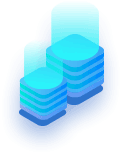With the development of science and technology, various new concepts and topics are also blooming. In the past few years, the high-tech terms such as big data and cloud computing have sprung up like mushrooms after rain. Now there is another edge computing.
The cloud computing and edge computing can be imagined as a neural network diagram of the human brain. If cloud computing is regarded as the brain, then edge computing is like the neural tentacles output by the brain. These tentacles are connected to various terminals to run various actions.
To be precise, cloud computing is a centralized service, and all data is transmitted through the network to the cloud computing center for processing. By coordinating many computer resources together, users can obtain unlimited resources through the network, and the resources obtained are not limited by time and space.
Edge computing is on the side close to the source of the object or data, using an open platform that integrates network, computing, storage, and application core capabilities to provide the most end-to-end services nearby. Its applications are initiated on the edge side, resulting in faster network service responses and meeting the basic needs of the industry in real-time business, application intelligence, security and privacy protection.
At this stage, cloud computing has developed to a relatively mature stage. So what does cloud computing do for us in real life?
1. Storage cloud
Cloud storage is a cloud computing system with data storage and management as its core. Users can upload local resources to the cloud, and can connect to the Internet anywhere to obtain resources on the cloud. The well-known large network companies such as Baidu, Google, Microsoft, and Ali all have cloud storage services.
2. Medical Cloud
Medical cloud refers to the cloud computing, mobile technology, multimedia, 4G communication, big data and the Internet of Things and other new technologies, combined with medical technology, using cloud computing to create a medical and health service cloud platform, to achieve the sharing of medical resources and medical care expansion of scope.
3. Financial cloud
Financial cloud refers to the use of cloud computing model to disperse information, financial and service functions into the Internet "cloud" composed of huge branches, aiming to provide Internet processing and operation services for financial institutions such as banks, insurance and funds, and at the same time. Share Internet resources to solve existing problems and achieve the goal of high efficiency and low cost of edge computing in financial services.
4. Education Cloud
In essence, it refers to a development of educational informatization. The now popular massively open online course MOOC (MOOC) is an application of education cloud.
However, centralized cloud data centers have their own limitations. In the future, in the 5G or even 6G era, the network will require ultra-high bandwidth, ultra-high density, and ultra-low latency. This means that the amount of data to be carried by the mobile communication network will be dozens, hundreds, and thousands of times that of the current one. If a single cloud computing model is still adopted, the speed and delay cannot be guaranteed. What should we do?
The European Telecommunications Standards Institute (ETSI) proposed the concept of edge computing, which is a network architecture that provides services and cloud computing functions required by users on the wireless side, which is used to accelerate the rapid download of various applications in the network, allowing Users enjoy uninterrupted high-quality network experience, with ultra-low latency, ultra-high bandwidth, and strong real-time performance.
Compared with cloud computing, edge computing has the following advantages:
Data processing can be performed in real time or faster, reducing end-to-end latency;
It can reduce the data traffic in the backbone network and release the pressure on the backbone network;
By reducing the latency level, the efficiency of the application can be improved;
Through the convenience of edge computing, the demand model can be adjusted to obtain a personalized interactive experience.
In addition to this, there is a particularly important issue of security and privacy protection.
As one of the trusted edge computing service providers, GOSDWAN sd wan company can not only effectively integrate the resources of public and hybrid cloud platforms distributed all over the world, but also match relevant low latency networks to cover the "last mile". With rich experience in logistics, customs clearance and equipment management at the customer's site, we can support customers to quickly and cost-effectively obtain all computing layer resources required by sd-wan edge computing services.





